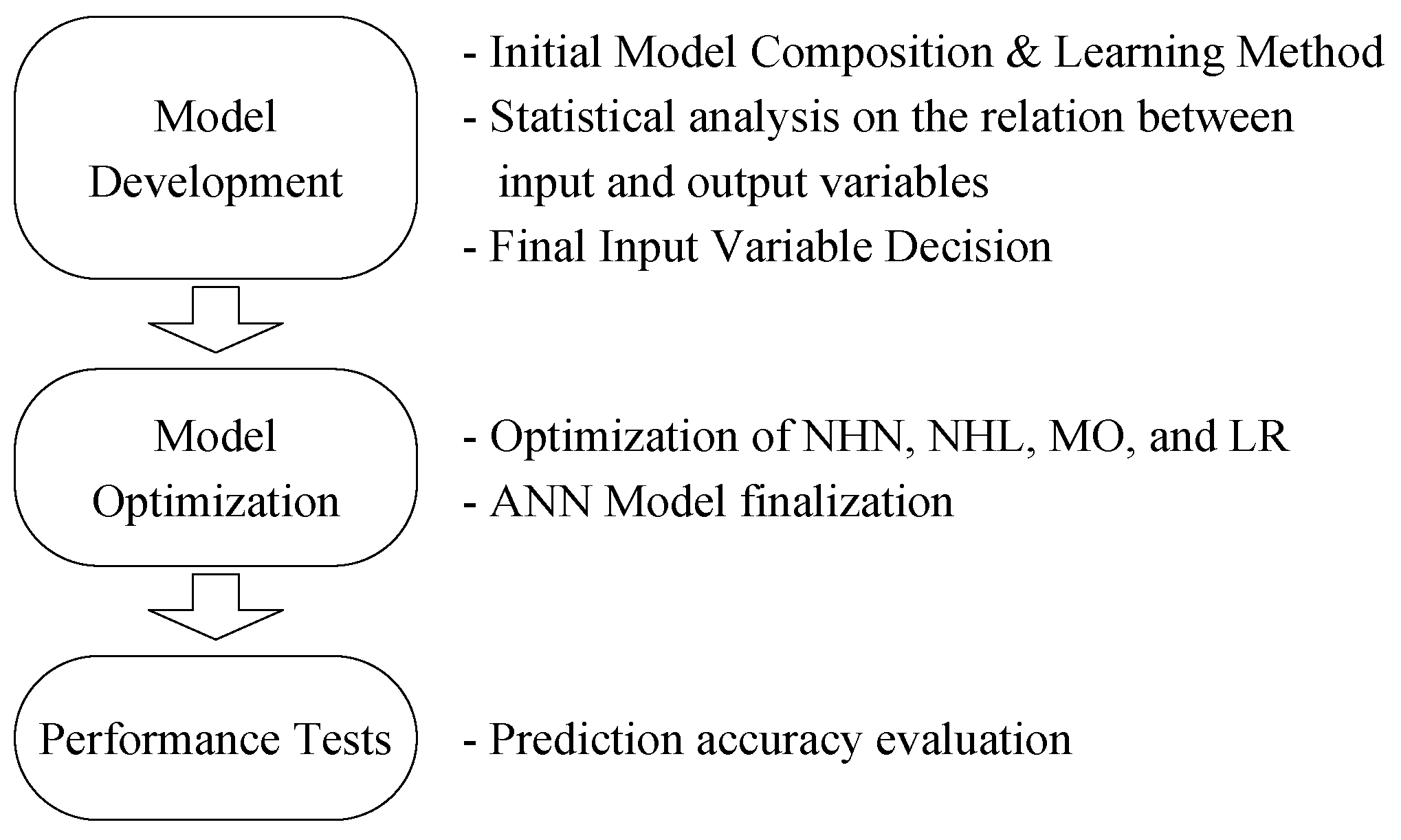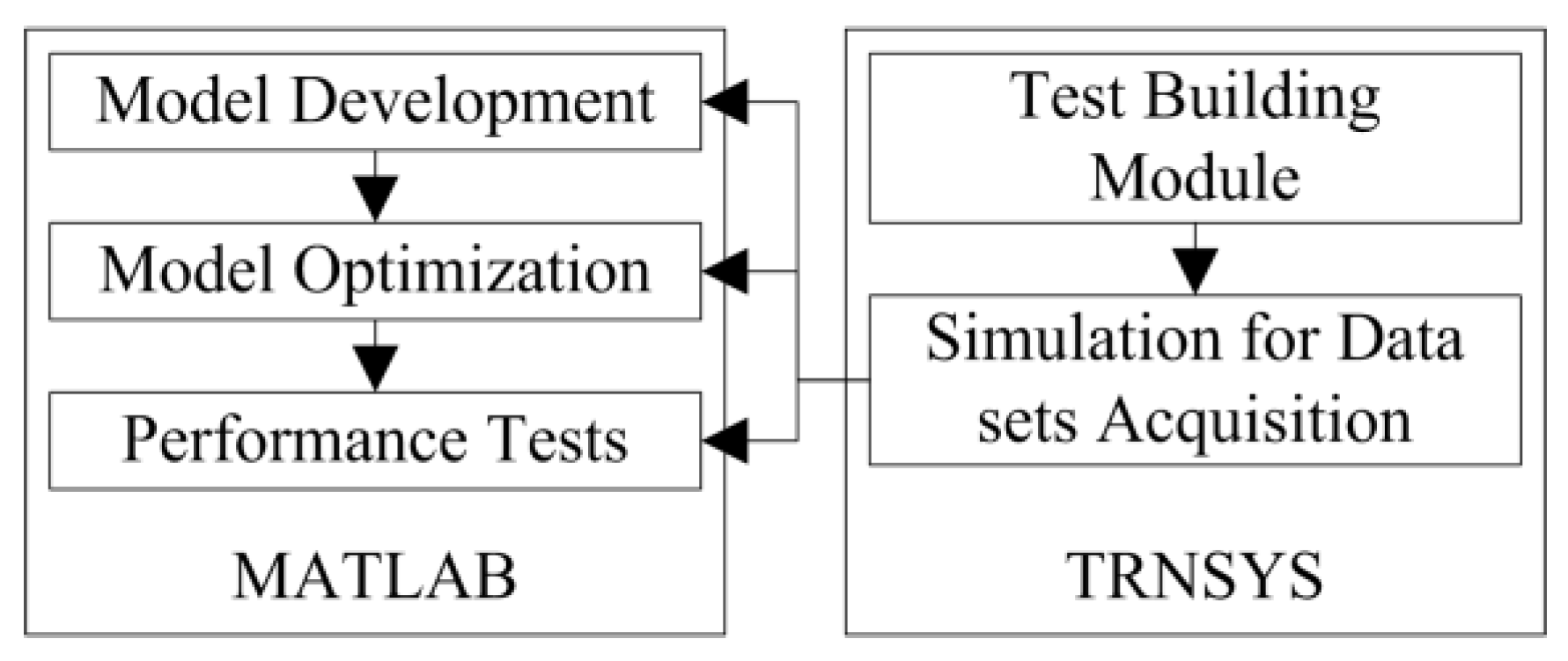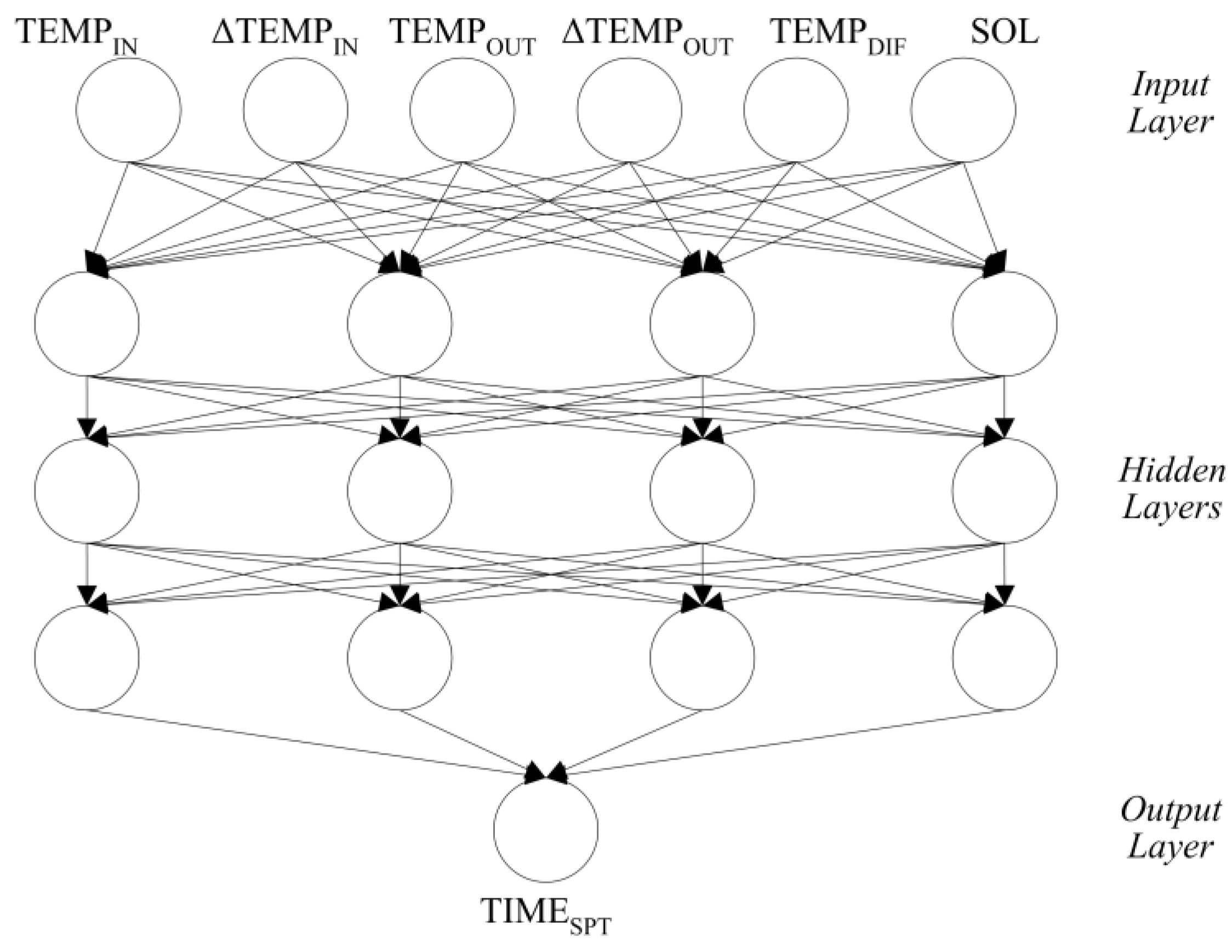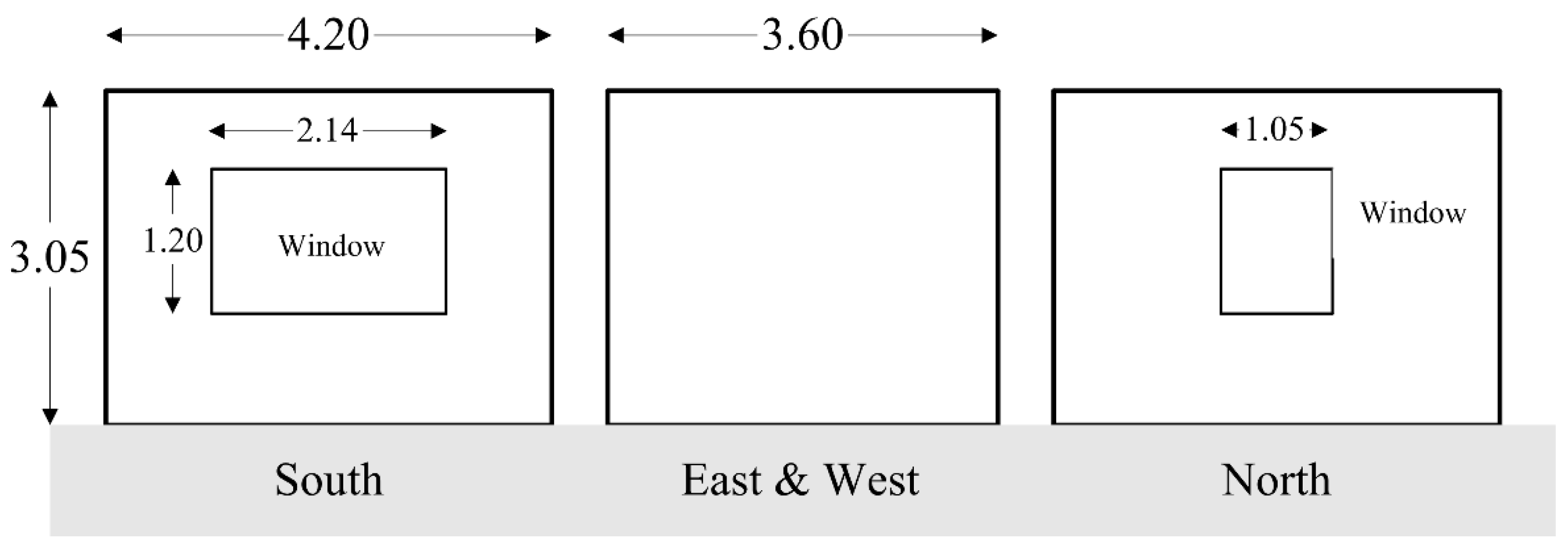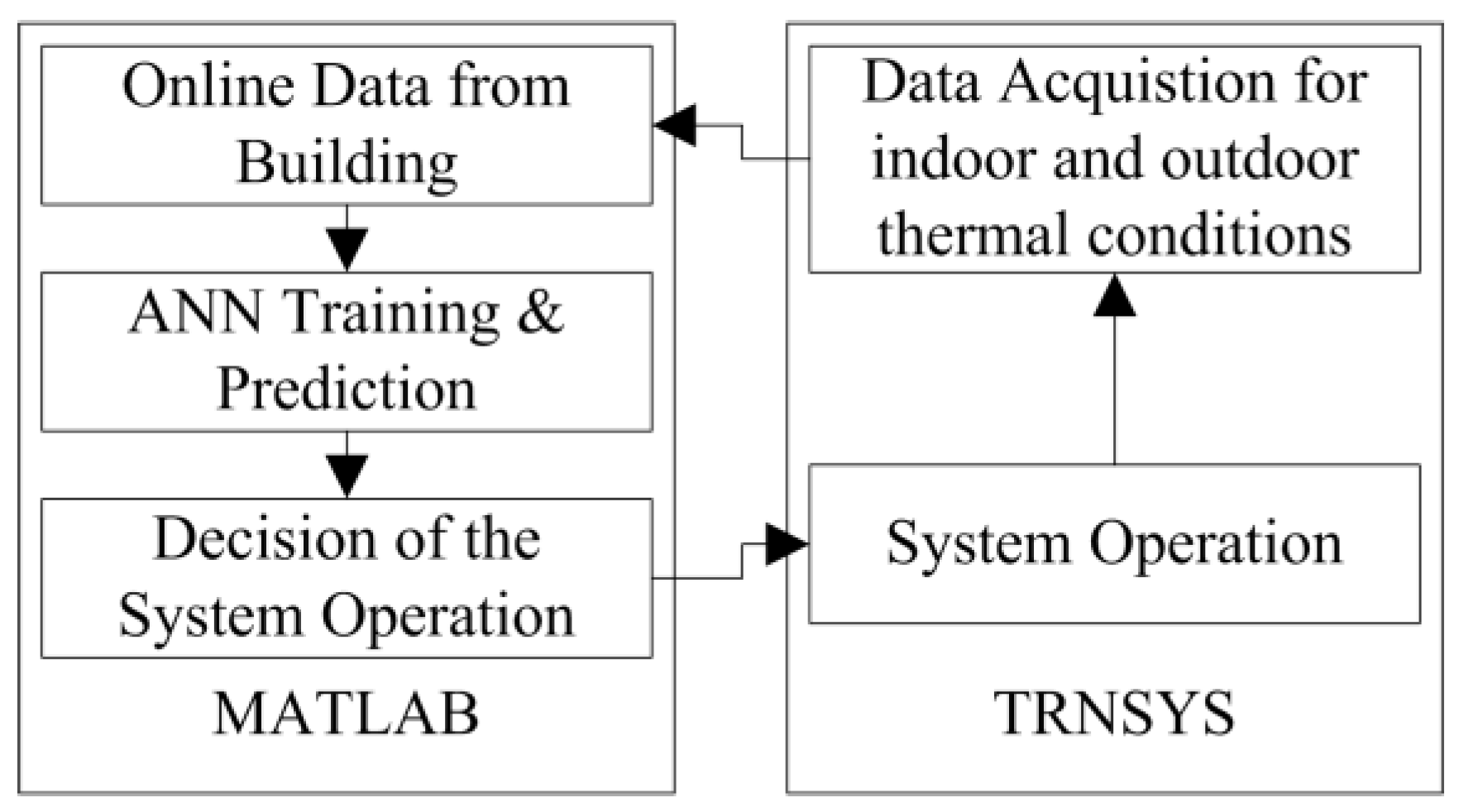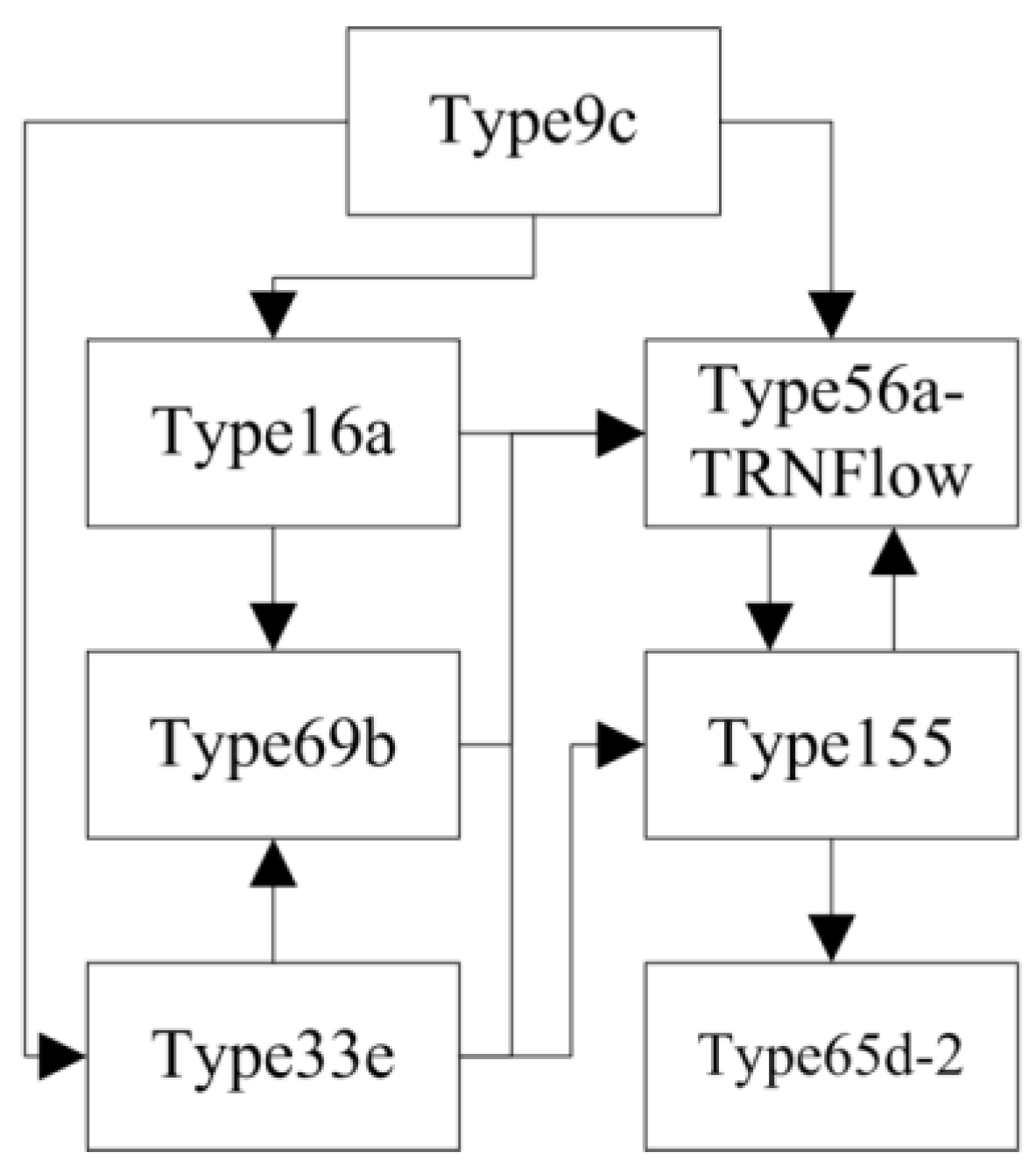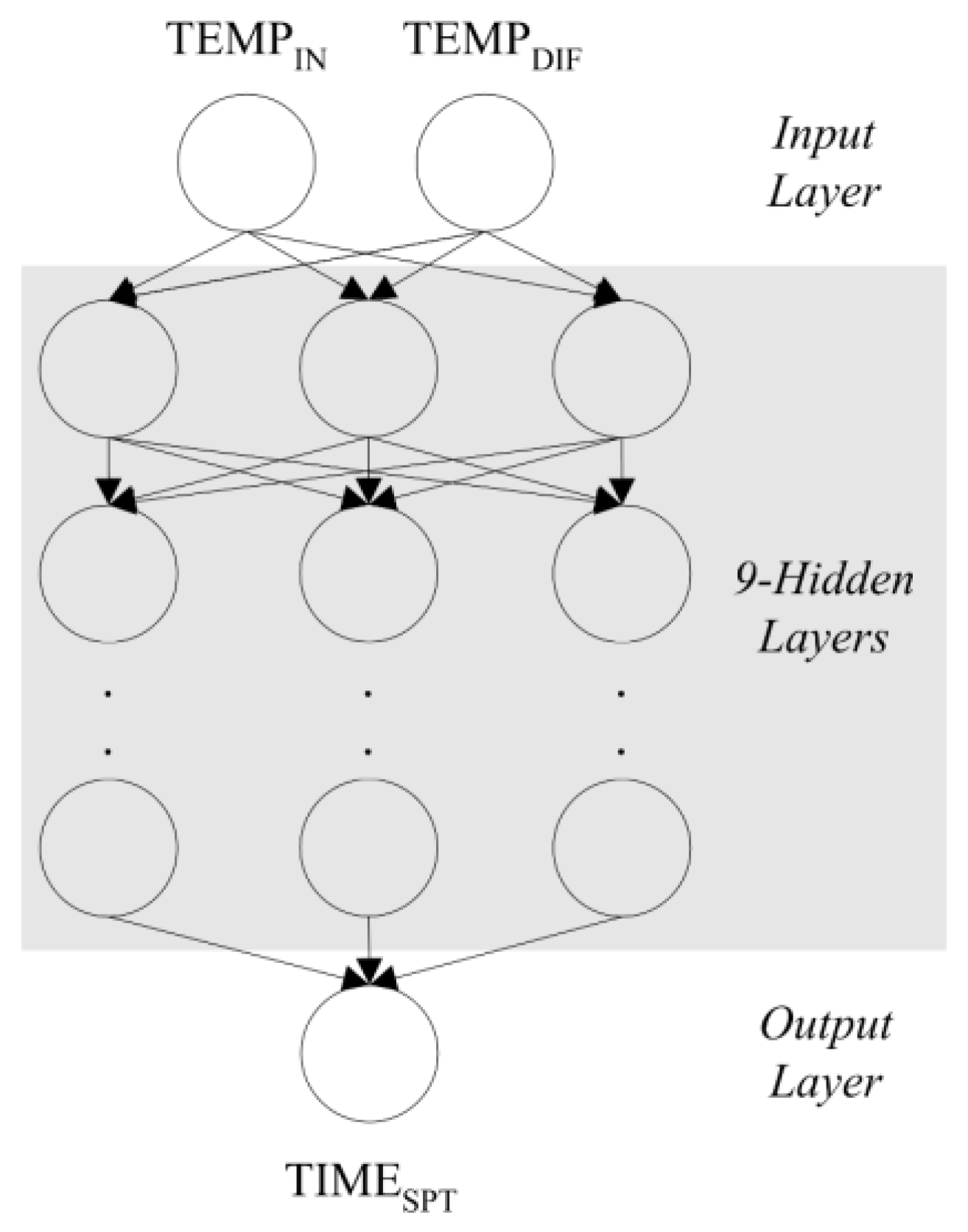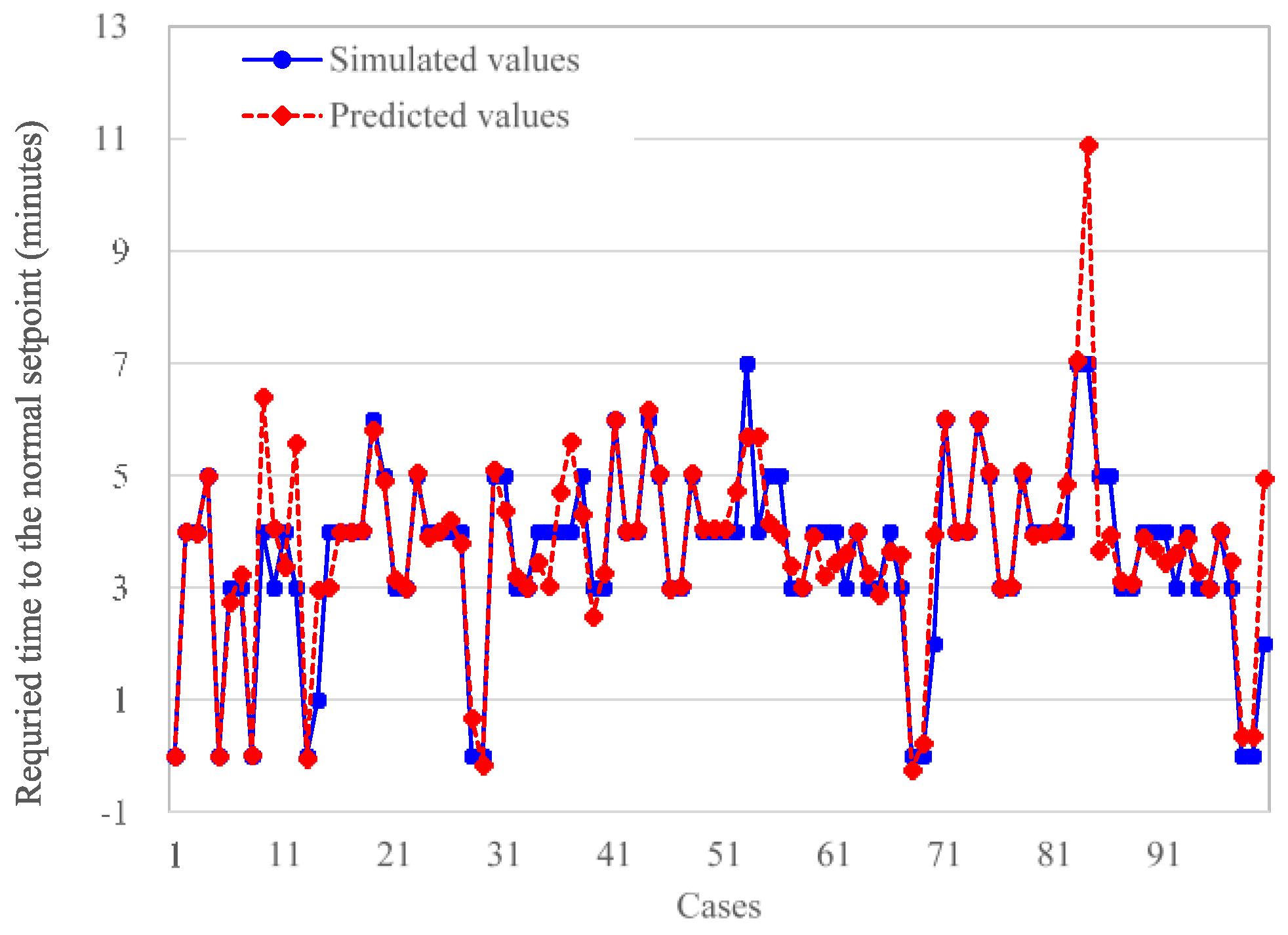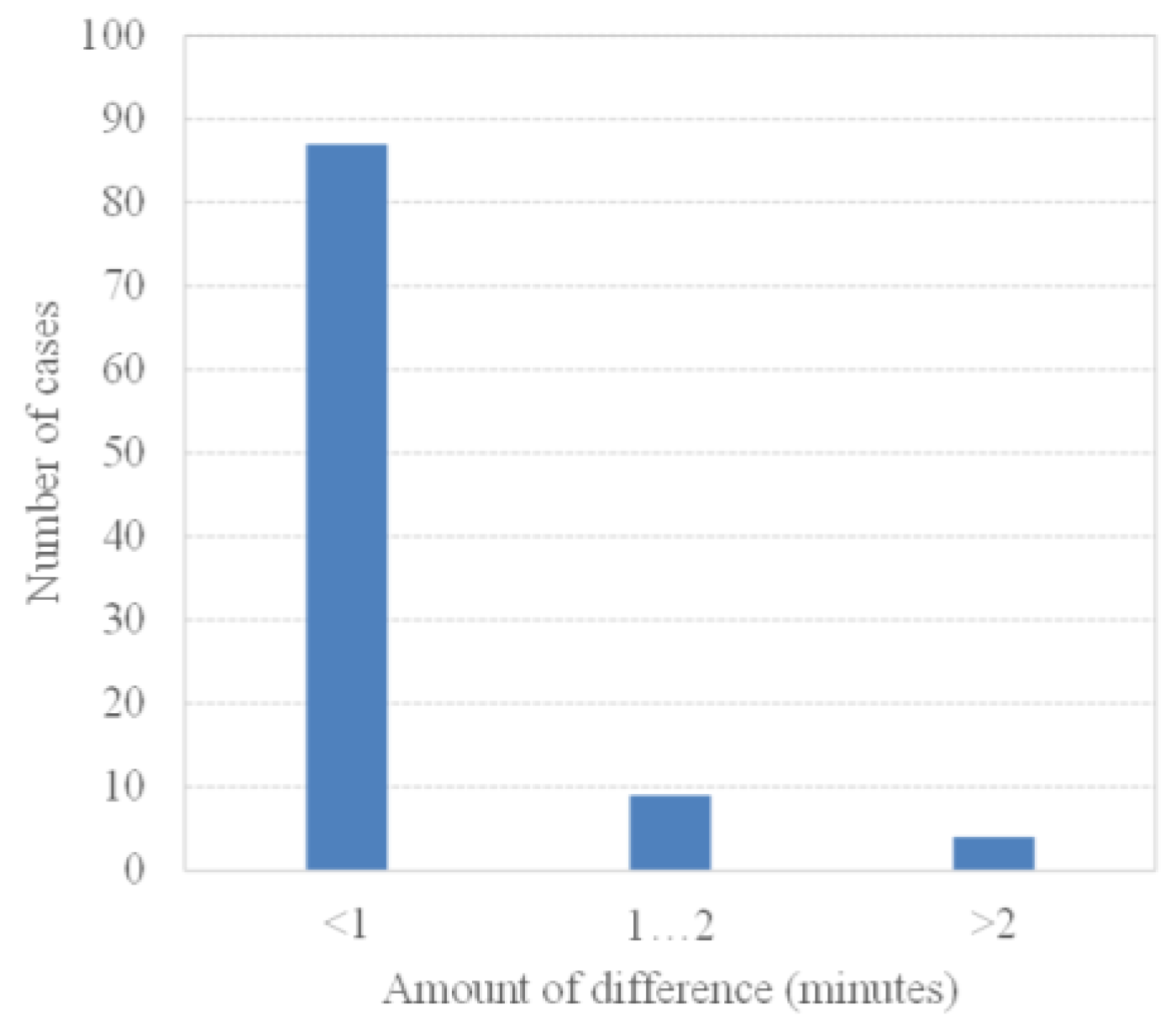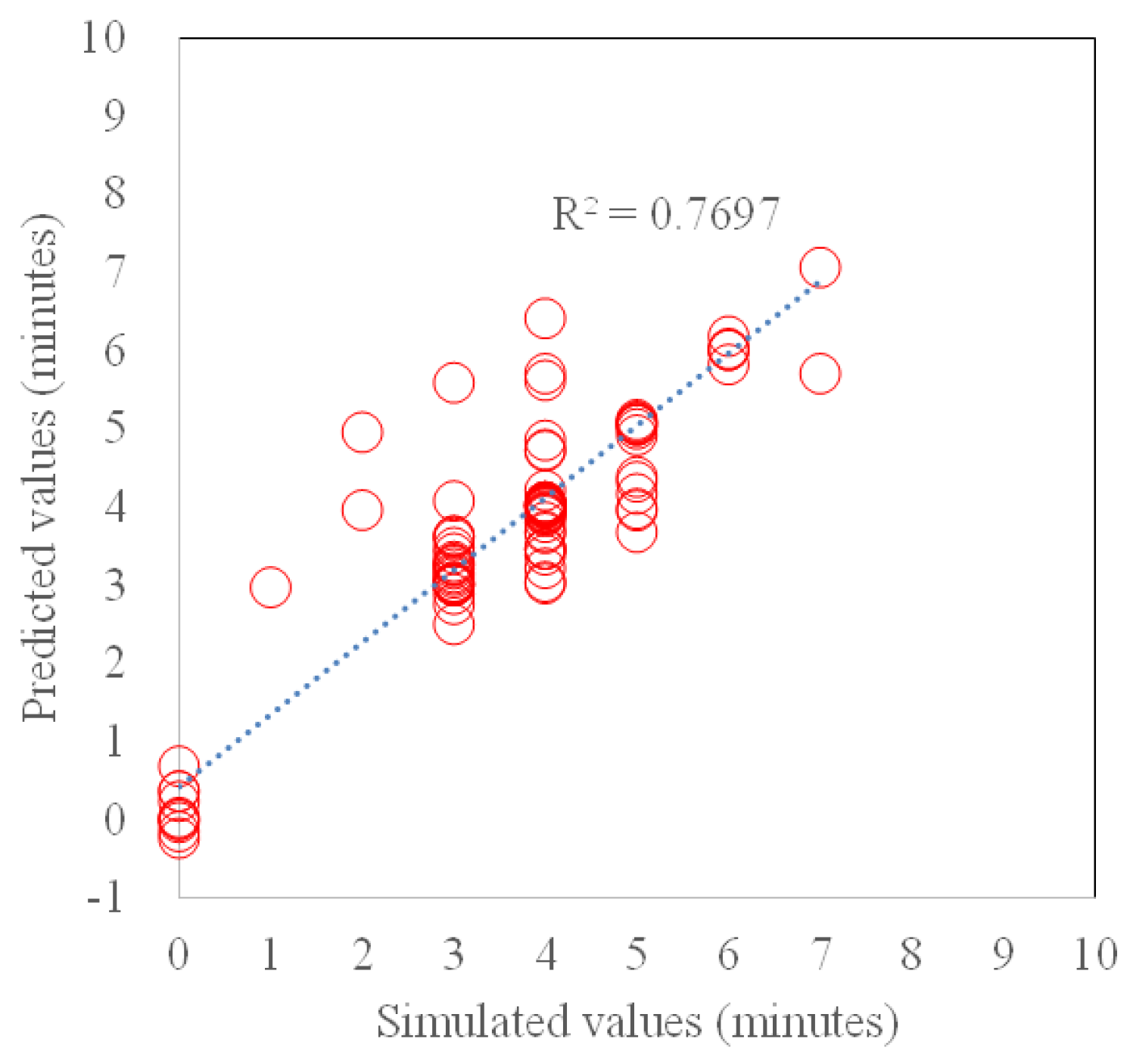1. Introduction
People are now spending around 90% of their time indoors [
1]. Therefore, indoor environmental quality (IEQ) has become a significant factor for building occupants’ quality of life. Comfort, health, and productivity are affected by IEQ, and it can significantly affect occupant behavior [
2]. Properly provided IEQ in commercial buildings can reduce absenteeism rates and employee turnover, and increase productivity. Better IEQ can lead to fewer errors and accidents, and improve product and service quality [
3]. In addition, proper IEQ can reduce health hazards [
4,
5,
6,
7,
8].
Heating and cooling systems account for 58.1% of total energy use in Korean residential buildings [
9,
10]. Residential thermostats allow occupants to control their setpoint timeframes and temperatures. This allows occupants to manage their personal comfort while reducing energy consumption.
A variety of building control systems using diverse types of energy have been applied to create a comfortable indoor environment. For example, heating and cooling systems, which aim to provide comfortable indoor thermal conditions, primarily account for most of the residential energy consumption. The amount of heating and cooling energy consumption reaches 58.1% of the total energy use in Korean residential buildings [
9,
10].
For providing comfortable thermal environment in an energy-efficient manner, a variety of theoretical and practical approaches have been studied and applied. The application of the thermostat for heating and cooling systems is one practical example that is widespread as a control method. The thermostat provides a function whereby users can determine their preferable setpoint and setback temperatures and periods. The application of thermostats is expected to provide two principal advantages: (1) improved thermal comfort; and (2) reduced energy consumption [
2].
Thermal comfort should be improved for two reasons. The first reason is that the indoor thermal environment can be adjusted to the desired level, and the second reason is that occupants can be psychologically satisfied with having an opportunity to control their thermal environment. In previous studies, occupants expressed increased satisfaction when they could use a thermal control device such as the thermostat to be involved in the thermal control process [
11,
12,
13].
In addition, using a thermostat that employs the setback temperature can save on the energy consumed for the thermal conditioning of the space. The setback temperature can be applied for the day- and nighttime for reducing energy consumption without compromising thermal comfort. In previously conducted experiments, field tests, and computer simulations, a significant energy saving effect of up to 30% for heating and 23% for cooling in residential buildings was reported [
14,
15,
16,
17,
18,
19]. Other types of buildings such as office buildings, hospitals, educational and religious buildings, etc. also achieved remarkable savings in energy consumption for thermal conditioning through the application of energy-conscious thermostats [
20,
21]. The programmable thermostat was an example of those thermostats, with which occupants could choose normal setpoint and setback temperatures and periods [
22].
Advanced strategies for the optimal programming of setback temperature such as adaptive, demand response, and virtual thermostats have been introduced to maximize thermal comfort and increase energy savings [
23,
24,
25,
26]. In particular, Yang and Kim investigated a method to determine the optimal start moment of the heating system using an artificial neural network (ANN) model [
27,
28]. The ANN model was designed to predict the required time for changing the indoor temperature to the desired temperature. Four input variables were employed as input neurons in the ANN model: indoor air temperature, varying rate of room air temperature, outdoor air temperature, and varying rate of outdoor air temperature. Model optimization was conducted for learning rate, momentum, nodes of hidden layer, and use of bias. The optimized model showed statistically meaningful prediction accuracy.
Despite the achievements of this research, two issues still need to be addressed. The first is the selection process for the input variables. In the previous study, the four input variables were selected as input neurons according to the factor analysis affecting room air temperature. However, no statistical analysis on the relationship between the input and output variables was conducted. Thus a simpler model, which excludes input variables having a lesser relationship, could be developed in further study.
The second issue is the optimization process of the model. The objective of the optimization was to find the ANN composition and learning method that would give the most accurate prediction results. For finding the optimized composition and learning method, the parameters to be optimized were tested independently and sequentially. After one factor (e.g., learning rate) was optimized, the next factor (e.g., momentum) was tested, to find the optimal value after fixing the first factor as an optimal value. Thus, an advanced method, such as coupling at least two of the investigated parameters, needs to be considered to provide an overall optimized model.
This study develops an ANN prediction model that calculates the required time to raise indoor temperature during the unoccupied setback period to the designated setpoint temperature for the occupied period (TIMESPT). The predicted value from the ANN model is used in the control algorithm to compute the optimal end of the setback period.
For example, if the summation of current time of day (TIMECUR) and predicted time (TIMESPT) during the setback period reaches the start moment of the normal occupied period, then the setback period is predetermined to actually end before the occupied period begins. As a result, the indoor temperature will rise to the comfort level when the occupied period begins. As the prediction model calculates the optimal moment, it can also reduce the energy that will be consumed for pre-heating unnecessarily early before the normal period.
There are two principal reasons to choose the ANN theory to predict TIME
SPT in this study. The first is that the ANN model can adopt input variables flexibly. Unlike fuzzy logic (FL) or adaptive neuro fuzzy inference systems (ANFIS), an ANN model can employ a series of inputs for producing outputs. The second reason is that ANN models have proven their stable prediction accuracy and applicability to building thermal controls in the previous studies. These are summarized in
Section 2.1. We therefore selected the ANN model over than other machine learning theories.
Figure 1 shows the three major steps followed in this study. The first step was model development. The prediction model using ANN was built with initial composition and learning methods. Statistical analysis of the relationship between the input and output variables was performed to find the input variables that have a strong relationship with the output variable. Input variables with a strong relationship were then used as input neurons of the model.
The next step was model optimization. Model parameters such as the number of number of hidden neurons (NHN), hidden layers (NHL), momentum (MO), and learning rate (LR) were optimized to calculate the most accurate output. Optimization was performed in a coupled fashion, so that a series of NHN and NHL were tested together, followed by a series of MO and LR together. The ANN model employed parameter values for which the model predicted the most accurate output.
The root mean square error (RMSE) between the predicted results (Pi) and the simulated results (Si) was evaluated for each parameter variation. The Pi values were the predicted results from the ANN model, and the Si values were the calculated results from the test module using the MATLAB and TRNSYS software. The values presenting the least RMSE were assigned to the parameters.
The final step was to conduct performance tests on the optimized model. The prediction accuracy of the ANN model was investigated using new data sets. The applicability of the proposed model was presented based on this performance evaluation.
Two major contributions are provided in this study: (1) a method for designing the ANN model and (2) a specific role for the integrated control algorithm. To overcome the limitations of the previous model, this study conducted two steps (the first and second steps in
Figure 1) for finding the meaningful input variables and composing the optimal ANN model. In addition, the proposed model will be embedded in the integrated algorithm. This will be introduced in
Section 2.3. Flowchart of the Control Algorithm. Three ANN models will be used to determine comfortable thermal environments while saving energy. In particular, the model developed in this study will provide a comfortable thermal environment at the beginning of the normal occupied period minimizing the unnecessary energy consumption.
The development process is presented in
Section 2 including previous studies on the predictive controls using ANN in
Section 2.1, the flowchart of the control algorithm in
Section 2.2, and the artificial neural network model in
Section 2.3. The results of the optimized model are described in
Section 3, followed by conclusions in
Section 4.
4. Conclusions
In order to develop an ANN prediction model for calculating the time (TIME
SPT) required to raise indoor temperature during the unoccupied setback period to the designated target setpoint temperature, three major steps were completed in this study: (1) model development; (2) model optimization; and (3) performance evaluation. Our findings are summarized as follows:
- (1)
The correlation analysis (R2) between input variables and output variable (1st step) revealed that TEMPIN and TEMPDIF (input variables) presented relatively strong relationships with TIMPSPT (output variable). Therefore, these two variables were selected as input neurons for the initial ANN model.
- (2)
Using RMSE to analyze the difference between the simulated outputs (Si) and predicted outputs (Pi) from the ANN model for different ANN parameter values (2nd step) revealed that the least RMSE was produced when applying nine hidden neurons in each hidden layer, three hidden layers, a 0.9 momentum, and a 0.9 learning rate to the ANN model. Therefore, the ANN model was optimized with these final values.
- (3)
From the performance tests, the proposed ANN model proved its prediction accuracy. The CVRMSE between the simulated outputs and predicted outputs (22.74%) was lower than the generally accepted level (30.0%). In addition, the difference between them for most of the cases was less than 1 min.
In conclusion, based on the previous study [
27,
28], the more progressive methodology was applied for composing and optimizing the ANN model in this study. First, the meaningful input variables were selected based on their statistical relationship analysis. Then structure and learning methods for the model were optimized in a coupled fashion. The model developed using the new method showed an acceptable prediction accuracy, therefore it was applied to the control algorithm.
The control algorithm employed multiple ANN models. As summarized in
Table 1, each model had its prediction target. Using the predicted values from three ANN models, the heating system will start and stop the setback period more accurately as well as create more comfortable and stable indoor temperature conditions.
Overall, we used limited boundary conditions for the performance tests in this study. To ensure that the potential results can be achieved, these performance tests should be conducted in an actual building. Along with the field tests, additional performance tests should be conducted. To provide a solid basis for the proposed method, using other types of simulation methods should also be undertaken. Using MATLAB and EnergyPlus software, and incorporating it with Building Controls Virtual Test Bed (BVCTB) for connecting the two, is proposed as the good method to test the predictive control strategies [
60,
61].
In addition, the proposed ANN model performance needs to be comparatively investigated by using diverse optimization schemes such as the constructal theory or entropy generation minimization methods. Also, other machine learning methods such as support vector machine (SVM), random neural network (RNN), and model predictive controller (MPC), should be compared to the proposed model. Those methods were stated to predict the indoor temperature conditions more accurately and to maintain indoor temperature more stably in a couple of studies [
62,
63]. Through these comparative tests, the most applicable method will be found. Finally, the control algorithm, as previously shown in
Figure 2, needs to be organized to employ the proposed prediction model and tested for its performance in further studies.
